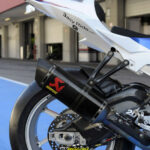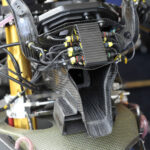Over a decade ago I headed to Portimao to ride the WorldSBK machines. The BMW was of particular interest, as I had ridden the first model at the same circuit and some domestic BMW superbikes here in OZ. It turned out to be Troy’s final World Superbike.

Check out our other racer tests here…
The 2011 season marked an exciting time for BMW Motorrad Motorsport WSBK team. After an encouraging debut season in 2009, where the team achieved 17 top 10 finishes, followed by a first pole position and podium in 2010, 2011 was going to be the year that the team could concentrate on racing for more podiums and perhaps an ambitious win…

Rainer Baumel, previously technical director, moved into the role of Head Of Race Operations, while Stephan Fischer became Head Of Development and logistics, personnel, finance and responsibility for the race factory was placed in the hands of alpha Racing Manager Josef Hofmann.

There were extensive changes to the machine for 2011. The engine specifications were dramatically altered to give more mid-range power, evident by the use of a new shorter exhaust pipe. But maximum power was increased to 220RWHP. The year began with specification engine number nine and spec 10 was introduced mid season. The goal was to increase top end without losing mid range. This was achieved and saw a 5hp increase.
However, maximum power is not the only criterion in WSBK, with throttle response being equally important. The BMW S 1000 RR throttle-bodies are controlled by a ride-by-wire system that was continually developed throughout the season. It is controlled by an RSM5 management system, developed in-house by BMW Motorrad Motorsport.

Chassis-wise, there was also a lot changed for 2011. The weight distribution of the bike was optimised with the seating position of the rider shifted back to increase weight over the rear of the bike. The fuel tank was also new, as was the rear sub-frame and new Ohlins TRSP25 forks were used. Also, interestingly, a cast rear swingarm replaced the previous fabricated swingarm. Lastly, new livery was added to the carbon-fibre fairings to make bike look more like the limited edition blue and white road version. Nice touch…
THE RIDE
By the time I rode the BMW of hero Troy Corser, I’d already sampled the Althea Ducati, Yamaha, Alitalia Aprilia and a few 600s. So I was well and truly back in the groove on the track and the nerves had settled. As much as they can when riding a World Superbike!

The BMW Motorrad Motorsport pit set up was the most professional of the lot. It was incredibly clean and the team were really friendly. Fellow Speed TV WSBK face Steve Martin was hanging around so I had a chat with Steve about the bike he played such a big role in developing. Troy Corser popped in to the pit garage however I was not able to get a chance to chat to the two-time WSBK champ sadly.

Looking over the bike, the attention to detail is incredible. From the stunning Akropovic shorty four-into-one to the amazing and huge handmade radiator, the bike is incredibly perfect to the eye. Not a mark or a scratch and nothing looks like its worth anything under a million bucks.
I’d overheard a few fellow journalists complaining that the electronics on the bike were too intrusive, perhaps set too conservatively for some of us, so as the team fired up the bike I was a little concerned the ride might be less than the real deal – so far on the day every other team had left the bikes as raced, and showed us the data to prove that – and the settings they used.

The bike was fired up and I jumped on. The first thing that blew me away was just how tiny the machine is and how compact Troy must be! He’s no Marco Melandri midget but I was more cramped on Troy’s bike than on Marco’s, Checa’s, Rea’s or Biaggi’s machines.

The ‘bars are very traditionally positioned – wide, pulled back with an angle downwards. The levers are tiny and only for two-fingers. And the footpegs very, very narrow. The seating position feels way back over the rear wheel and despite the ride height in the bike; it feels rear biased and low. Overall, tiny. I felt like I was on a 250!
The engine idled over at a fast pace as I clicked up into first gear and headed off down pit lane with a fist full of revs to get moving in the tall first gear. The pit lane limiter kept me at 40km/h then automatically switched off as I exited onto the end of Portimao’s fast chute.

I was lucky again as I had new tyres. So I put my head down and started to push from turn three onwards. The peaky nature of the bike was immediately noticeable and it did not have the punch and throttle response off the turns that the other fours enjoy and nowhere near the Ducati. However, the throttle could be opened really early without torque tying the bike in knots – and the top-end acceleration was incredible. Much more than the Castrol Honda or the Yamaha and similar in feeling to the Alitalia Aprilia.
It was about now that I got into a rhythm and the electronics started to spoil my fun. At anything but close to upright the bike would cut ignition and fuel and splutter off the turns slower than a 600 supersport bike. In fact, the bike felt slower than the street bike in some instances. Off any of the first or second gear corners, right on apex when I started to pickup the throttle and feed some power in, the traction control would cut in and sometimes it almost caused me to crash when the bike did not react to the throttle and pick itself up to drive off the corner. To adapt I had to basically park it turn, stand it up and fire it off the corners. It was a shame as most of us there were experienced racers and should have been given the opportunity to ride the bikes as raced.

The only other theory s that Troy is carrying more speed and higher rpm at that lean angle and the TC is set to be less intrusive there – so I was not riding in the same rpm range as him, therefore the TC was misbehaving. However, after speaking with the other test riders, the experience was a common one apart from for the really slow guys that were not opening the throttle hard enough.
The handling of the bike was different to the other four-cylinder machines. Firstly, Troy has the set-up very stiff compared to all of the other superbikes. And as mentioned, you really feel like you are riding the rear wheel everywhere – whereas looking at the bike in 2009 and 2010 it looked very forward biased and Troy was a weapon at running it into corners blindingly fast.

With the narrow footpegs and tiny levers, I felt like I was slipping off the bike and I could not get the hang of the thumb rear brake – but I did make a point of trying it. I reckon once you got used to the mental mechanical action it would be brilliant.
Initial turn-in on the bike is brilliant. The steering light and agile and I could get the turning process done more quickly than I could on the other fours. There is a mix of braking turns and non braking turns at Portimao and the bike was great in both situations, turning with accuracy and speed and not much effort. However, I found that I had to put quite a lot of effort into keeping the BMW on its side through a turn, really using my outside knee to hold the bike down. On picking up the throttle for exit, the bike would snap and try to stand up. So running a long, accelerating line off a corner was difficult. It was a shame, as the lack of torque made the bike easiest to open the throttle early on and the chassis should not get upset so much without torque there to tie it in knots…
I think it was a combination of me not fitting in the seating position and having my 90kg at the time weight over the rear wheel, plus the aggressive nature of the engine in the higher rpm in some situations, that caused the reaction in the faster corners. In the slow corners I can’t explain it…
On the brakes the bike was extremely stable and the slipper clutch and back-shift system was brilliant. But with the thumb rear brake and stubby levers on the handlebars, the experience was different and would take some getting used to.

Acceleration down the front chute was definitely a thrill on the 220hp S 1000 RR as the electronics battled to keep the front wheel on the ground coming over the crest at 200-odd km/h before accelerating to close to 300 before the braking area. And experiencing how the electronics work was great, although it would have been more interesting if it was raining for example.
Overall I really enjoyed the ride but left thinking that the ASBK winning S 1000 RR of Glenn Allerton is a better handling package and I wonder how Troy would go on that if it had another 20hp…
BMW Motorrad Motorsport 2011 Season
Team Partner: alpha Racing
BMW Motorrad Motorsport Director: Bernhard Gobmeier
Head of Race Operations: Rainer Bäumel
Head of Development: Stephan Fischer
Managing Director Stephanskirchen: Josef Hofmann
Riders: Troy Corser, Leon Haslam
Crew Chief Troy Corser: Tom Larsen
Crew Chief Leon Haslam: Giacomo Guidotti
TROY CORSER – active WSBK 1992 – 2011.
Date of birth: 27th November 1971 in Wollongong
Place of residence: Monte Carlo
Nationality: Australian
Marital status: Married to Sam, two children: Kalani and Kelisa
Height: 1.70m
Weight: 68kg
Hobbies: Golf, wakeboarding, karting, jet ski, motocross
Passion: Racing
Favourite circuits: Phillip Island, Valencia, Portimão
First bike: Yamaha TY80, Honda CR80
First race: 1989 Australian Production Series 250cc
Career highlights: 1996 Superbike World Champion, 2005 Superbike World Champion
World Superbike record: 377 race starts, 130 podiums
33 wins, 47 seconds and 50 third places, 43 pole positions, 45 fastest laps
Troy Corser’s WorldSBK BMW S 1000 RR Specifications
Power: Over 220hp
Wet weight: 162kg
Fuel capacity: 23L
Engine: Liquid-cooled, inline four-cylinder, DOHC, 16-valve, four-stroke, Bore and stroke 80 x 49.7mm, 999cc, compression ratio: 14:1, fuel delivery: Dell’Orto fuel management system with 48mm throttle-bodies, gearbox: Six-speed cassette-style, clutch: wet multi-plate slipper clutch
Frame type: Twin-spar alloy frame with adjustable geometry
Wheelbase: Adjustable
Rake: Adjustable
Trail: Adjustable
Front suspension: Ohlins forks
Rear suspension: Ohlins TTX shock
Front brakes: Dual 320mm Brembo rotors with Brembo four-piston radial-mount monoblock calipers and radial-pull master-cylinder
Rear brake: Brembo
Front wheel: OZ Racing
Rear wheel: OZ Racing
Front tyre: Pirelli Slick, 120/70 – 16.5
Rear tyre: Pirelli Slick, 190/50 – 16.5 or 200/55 – 16.5
Instruments: BMW Racing














